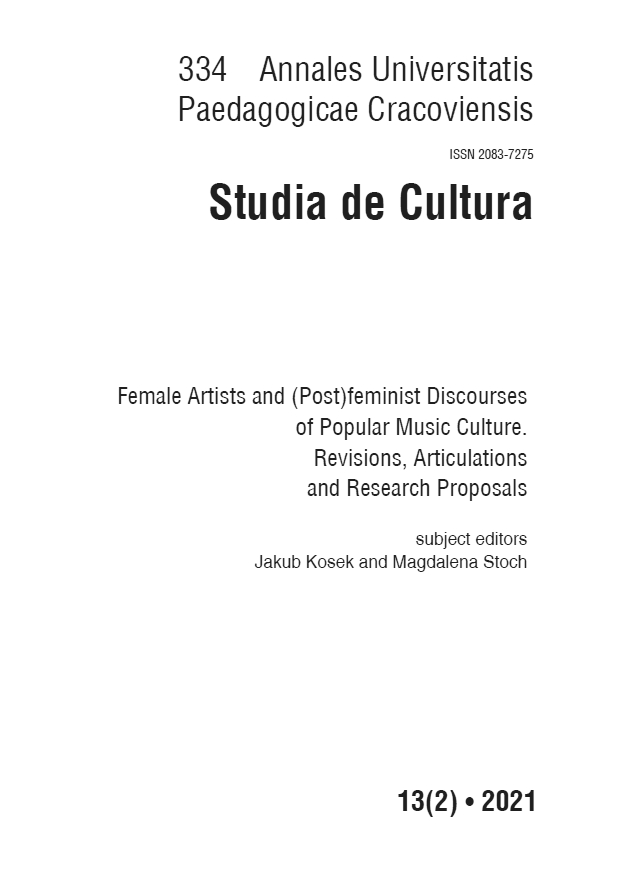Abstract
Feminism in music is not a new concept, but we can observe a new wave of pop feminism in pop music, in a younger generation of female artists. They are open to discuss taboo topics, connected to carnality, sexuality, body positivity or feminism. The artists such as Miley Cyrus, Beyoncé, Pink, Avril Lavigne or Taylor Swift, with more courage are presenting in their creation, until now - taboo topics, rejected in mainstream music. They are not afraid of portraying topics, such as: sexual freedom, women’s rights, the objectification of women, men power and domination, social injustice, fat shaming, slut-shaming, or existence of unfair stereotypes. They are also advocating the legalization of homosexual relationships, race equality and human rights.
References
Alexandra Rae. “Girls To The Front: 25 Years of Bikini Kill, Riot Grrrl and the Enduring Legacy of Kathleen Hanna”. Kerrang. https://www.kerrang.com/features/25-yearsof-bikini-kill-riot-grrl/ (access: 25.09.2020).
View in Google Scholar
Banet-Weiser Sarah. 2018. Empowered: Popular Feminism and Popular Misogyny. Durham.9.
View in Google Scholar
Chutnik Sylwia. 2017. “‘Sorry za bazgroły’. Typografia i topografia kobiecych zinów”. Kultura Współczesna no. 4(97). 45–46.
View in Google Scholar
Gillett Katy. 2019. “Did the Spice Girls’ message of ‘girl power’ really have anything to do with female empowerment”. The National. https://www.thenational.ae/arts-culture/comment/did-the-spice-girls-message-of-girl-power-really-have-anythingto-do-with-female-empowerment-1.865593 (access: 25.09.2020).
View in Google Scholar
Greenblatt Stephen. 1995. Culture. In: Critical Terms for Literary Studies. Frank Lentricchia, Thomas McLaughlin (eds.). Chicago. 226.
View in Google Scholar
Hanna Kathleen. 1991. Riot Grrrl Manifesto. History is a weapon. https://www.historyisaweapon.com/defcon1/riotgrrrlmanifesto.html (access: 24.09.2020).
View in Google Scholar
Hunt El. 2019. “A Brief history of Riot Grrrl – the space-reclaiming 90s punk movement”. New Musical Express. https://www.nme.com/blogs/nme-blogs/brief-history-riot-grrrl-space-reclaiming-90s-punk-movement-2542166 (access: 24.09.2020).
View in Google Scholar
Hutchinson Kate. 2015. “Riot Grrrl: 10 of the Best”. The Guardian. https://www.theguardian.com/music/musicblog/2015/jan/28/riot-grrrl-10-of-the-best (access: 23.09.2020).
View in Google Scholar
Jeziński Marek. 2011. Muzyka popularna jako wehikuł ideologiczny. Toruń.
View in Google Scholar
Kaplan Ann. 2016. Rocking Around The Clock. Music Television, Postmodernism and Consumer Culture. New York.
View in Google Scholar
Kinder Marsha. 1988. “Teledyski a widz: telewizja, ideologia i marzenia senne”. Przekazy i Opinie. Monika Chabowska (transl.). No. 1–2. 90.
View in Google Scholar
Kawiorski Jan. 2002. Avril Lavigne: koniec ery Britney? https://kultura.onet.pl/muzyka/gatunki/pop/avril-lavigne-koniec-ery-britney/1c8fp3s (access: 26.09.2020).
View in Google Scholar
Łebkowska Anna. 2011. “Jak ucieleśnić ciało: o jednym z dylematów somatopoetyki”. Teksty Drugie no. 4. 11–27.
View in Google Scholar
Michalak Michał. 2011. Britney i Avril walczą o przełom. https://muzyka.interia.pl/pop/news-britney-i-avril-walcza-o-przelom,nId,1650478 (access: 25.09.2020).
View in Google Scholar
Ogonowska Agnieszka. 2021. „Media ucieleśnione. (Nowe) konteksty badawcze w relacjach media – ciało”. Annales Universitatis Paedagogicae Cracoviensis. Studia de Cultura no. 13(1). 36–54.
View in Google Scholar
Pacheco Sunitra. 2013. “Miley Cyrus shocks fans with her raunchy performance at MTV Video Music Awards 2013”. Financial Express. https://www.financialexpress.com/archive/miley-cyrus-shocks-fans-with-her-raunchy-performance-at-mtv-videomusic-awards–2013/1160800/ (access: 25.09.2020).
View in Google Scholar
Sherrod Lonnie R. 2006. Youth activism: An International Encyclopedia. Vol. 2 K-Z. London. 539.
View in Google Scholar
Shusterman Richard. 2005. “Somaestetyka”. Sebastian Stankiewicz (transl.). Biuletyn Polskiego Towarzystwa Estetycznego no. 7(1). 1–2.
View in Google Scholar
Skowronek Bogusław. 2013. Mediolingwistyka. Wprowadzenie. Kraków.
View in Google Scholar
Stachówna Grażyna. 1987. “O wideoklipach”. Powiększenie no. 3–4. 172.
View in Google Scholar
Stevens Jenny. 2016. “How the Spice Girls ripped ‘Girl Power’ from Its Radical Roots”. Vice. https://www.vice.com/en/article/bn3vq5/girl-power-spice-girls-jenny-stevens-geri-horner (access: 25.09.2020).
View in Google Scholar
Sztompka Piotr. 2005. Socjologia wizualna. Fotografia jako metoda badawcza. Warszawa.
View in Google Scholar
Szpunar Magdalena. 2016. Kultura cyfrowego narcyzmu. Kraków.
View in Google Scholar
Szymańska Karolina. 2011. Wpływ feminizmu na muzykologię – women’s studies, gender i kobiety w muzyce. In: Uniwersyteckie gry – czy płeć ma znaczenie? Wybrane dyskursy społeczno-edukacyjne. Monika Grochalska, Wiktor Sawczuk (eds.). Toruń. 164–171.
View in Google Scholar
“Time 100 Music Stars Prove This Was the Year of Pop Feminism”. The Time. https://time.com/ 74861/pop-star-feminism-beyonce-miley-cyrus-pharrell/ (access: 25.09.2020).
View in Google Scholar
Yarrow Allison. 2018. “How the Riot Grrrl Movement Sold the World on Girl Power”. The Daily Beast. https://www.thedailybeast.com/how-the-riot-grrrl-movement-soldthe-world-on-girl-power (access: 25.09.2020).
View in Google Scholar
Videography:
View in Google Scholar
Avril Lavigne. 2019. Dumb Blonde. https://youtu.be/wC022MwPHKI (access: 29.09.2020).
View in Google Scholar
Blues Pills. 2020. Proud Woman. https://youtu.be/HekZW4Pbg_I (access: 28.09.2020).
View in Google Scholar
Miley Cyrus. 2020. Mother’s Daughter. https://youtu.be/7T2RonyJ_Ts (access: 28.09.2020).
View in Google Scholar
Taylor Swift. 2020. The Man. https://youtu.be/AqAJLh9wuZ0 (access: 28.09.2020).
View in Google Scholar

This work is licensed under a Creative Commons Attribution-NonCommercial 4.0 International License.

